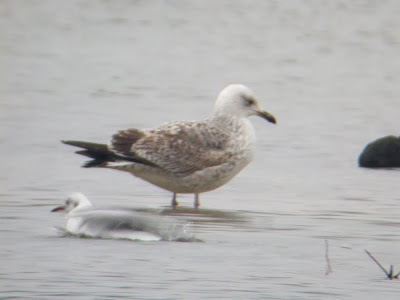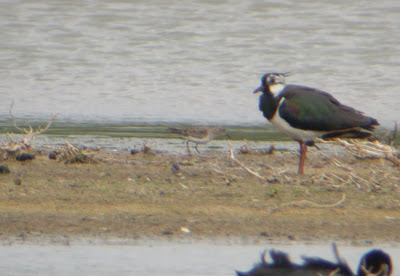As is customary, it is nice to reflect on some of the year's highlights, so here they are:
January had 2 different 1st winter Caspian Gulls, both hang overs from 2012, plus an adult which was seen just once:
Whilst over at the Roach pit, the 1st winter female Scaup also remained into the new year and actually stayed until mid March:
January also saw the start of a small influx of Pintail, which remained throughout the winter period, with numbers peaking in March in the mid teens - I counted 14 on March 1st:
I got a patch tick in late January with 2 Woodcock, but I was to see further birds on several evenings later in the winter, flying over towards the meadows at dusk.
February's best bird was probably the Jack Snipe found on the 19th amongst the amazing numbers of Snipe. There were 103 birds present that day, numbers being high throughout this period probably due to the flooding.
Another 1st winter Casp starting appearing fairly regularly from the 5th:
The highlight of March was another patch tick, Avocet - a flighty bird found on the 9th that was only present for a couple of hours before flying off.
On the 19th, yet another 1st winter Casp appeared. It was quite a striking bird and whilst browsing the Oxon bird blog, I found a similarly plumaged bird taken at Appleford, Oxon in December 2012. It looked to be the same bird and Ian Lewington thought so too!
Med Gulls started appearing more regularly during the month and I thought this 2nd summer bird on the 21st was particularly nice:
I will remember April for the discovery of not 1 but 2 Wood Warblers. The 1st appeared briefly on a very cold morning on the 20th, whilst 3 days later a different bird performed all day for the crowds:
A Spotted Redshank on the 24th was yet another patch tick, whilst April Arctic Terns and Whimbrel are now almost expected. 4 Arctics on the 18th and a Whimbrel on the 21st, with 2 more on the 26th. The 27th saw yet another 1st winter/summer Caspian Gull.
Early May's highlight and contender for bird of the year was a fly over Crane. It flew in from the east on the morning of the 6th and fortunately circled the car park area allowing a record shot before departing to the west.
The 7th saw the first of 3 Wood Sands during the year, whilst the 15th had another patch tick when a female type Marsh Harrier flew low north over the pit in the afternoon:
On the 18th, 2 Temminck's Stints were discovered in the early afternoon and they remained for the rest of the day:
A couple of days later, 2 Sanderling were in exactly the same spot on the spit:
The best bird in June was the 2nd Wood Sand of the year on the 24th.
July produced the year's 3rd Wood Sand with another adult bird present on the 3rd. Otherwise, it was the usual build up of post breeding gulls - in particular many colour ringed BHG seen in the previous year returned, including birds from Lithuania and Germany. The 1st juvenile Med Gull appeared on the 16th and remained for several weeks. It was joined by a 2nd bird on the 23rd only.
August was quiet, but the 1st returning Black-tailed Godwits were seen on the 3rd.
September had a small purple patch early on. A Ruff flew around and then off north on the 8th. The next day during inclement weather, 3 adult Sandwich Terns arrived, 2 departing and 1 staying through the afternoon. These were later traced as being initially in Oxfordshire, with the 2 departing birds also being seen at Staines Reservoirs later in the afternoon. On the 11th, I watched a juvenile Black Tern arrive from the north. It stayed a remarkable 14 days before departing the site.
On the 23rd 2 juvenile Arctic Terns were present during the afternoon:
The 27th saw another patch tick when a Marsh Tit vocalised its presence.
Not much in October apart from 2 Red-crested Pochard on the 11th. A late Reed Warbler was seen on the 7th.
November brought a surprise on the 15th when a chance encounter revealed the presence of a Brent Goose just to the north of the site. On relocating the bird, it proved to be the county's second record of Pale-bellied Brent and it was viewable from within the patch:
On the gull front, a 2nd winter Casp appeared on the 4th, whilst an unidentified near adult gull, presumed Yellow-legged, but possible hybrid was present on and off around the 5th:
Another 1st winter Casp was in the gull roost on the 29th, but December was a little disappointing with no particular highlights.
Here's hoping that 2014 can produce some similar decent birds!
























No comments:
Post a Comment